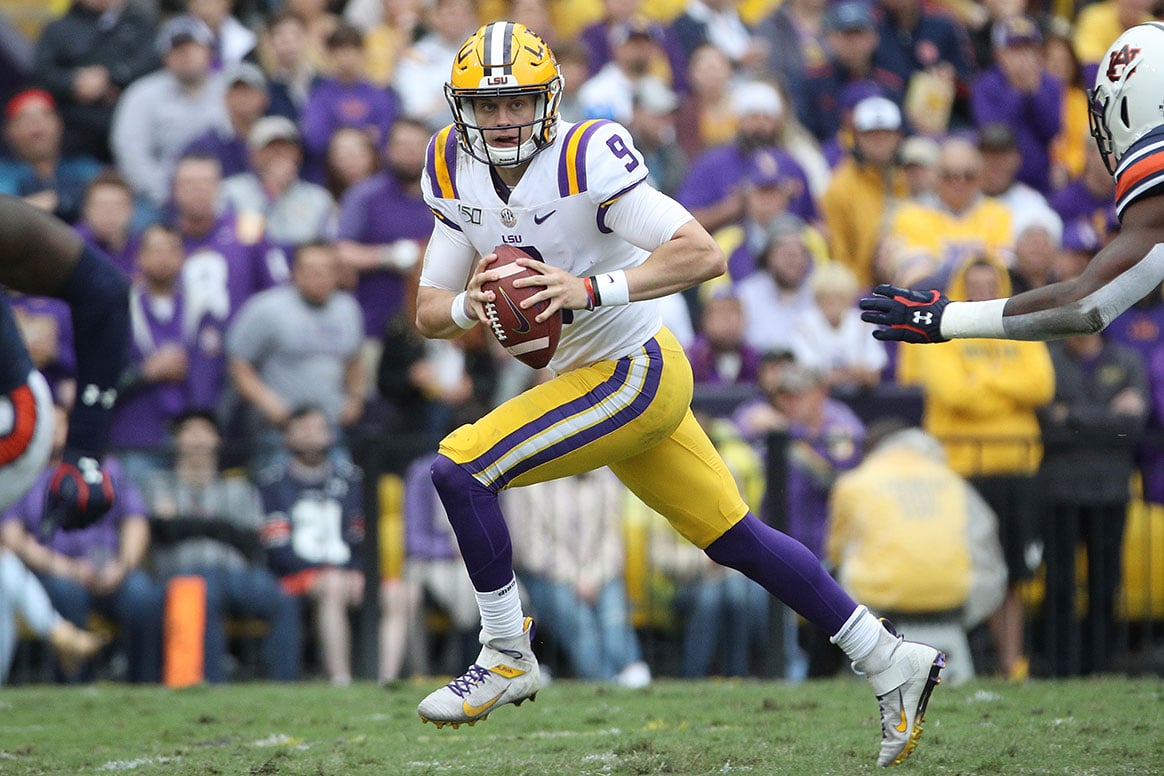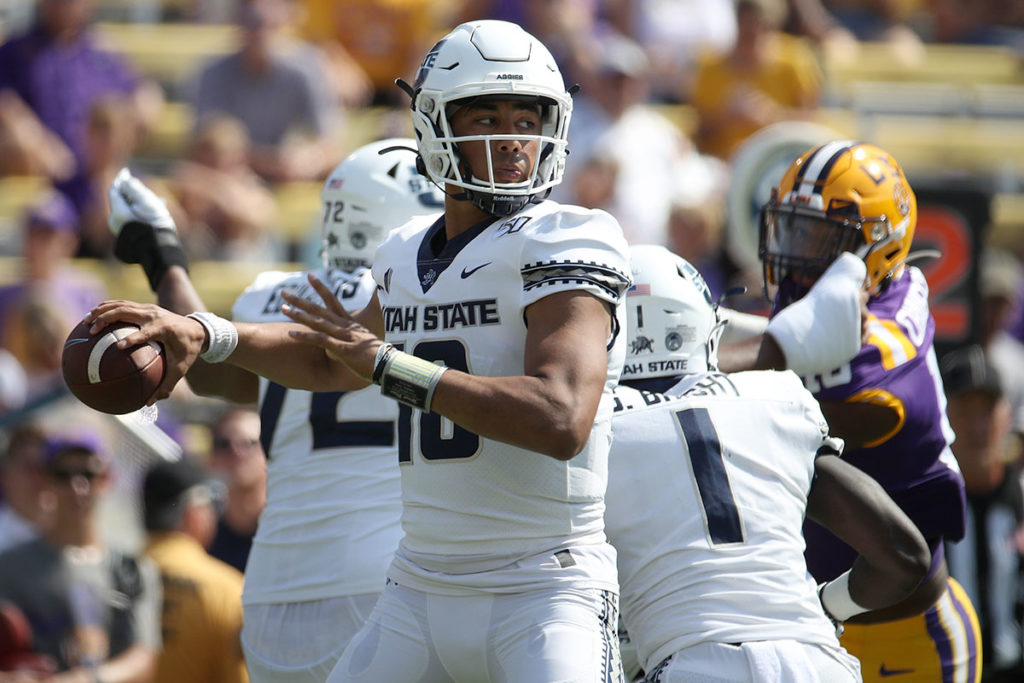It’s about three months later than I typically drop my first Top 50 Big Board for the NFL Draft, but it’s here. After starting at Pewter Report in February I’m still playing catch-up on many of these prospects, but I’m comfortable enough with the tape study I’ve put in to give you a Top 50. Look for a final Top 100 to drop a few days before the draft.
A couple things that are important to note about my grading process and my Top 50 Big Board so you don’t start your weekend overly triggered (maybe you still will):
• I model my grading scale after the approach of NFL teams, which means it is stingy. Most NFL teams have less first-round grades and smaller overall boards than those you see in the media. I’m not one of those analysts who will have 25 first-round grades and 40 second-round grades. The reality is that most players who attempt to make it in the NFL will not, and many that we project to be among the best at their position never get there. We all wish it wasn’t so, but that doesn’t stop it from being a reality.
As a result, my grading scale is pretty strict. Here’s the breakdown:
Can’t Miss Grades – Prospects that I believe will be among the very best at their position group by their third year in the NFL.
First-Round Grades – Prospects that I believe will be excellent starters in the NFL.
Second-Round Grades – Prospects that I believe will range from very good-to-good starters in the NFL.
Third-Round Grades – Solid starters, sometimes with significant upside that has yet to manifest itself consistently on the field, who will at their floor be important role players in the NFL.
Fourth-Round Grades – Spot starters at their ceiling, solid role players and backups with (hopefully) special teams value in the NFL.
• My board does NOT account for positional value at all, other than obviously excluding kickers, punters and long snappers because I don’t know how to scout them. For example, I have five running backs with a second-round grade in this class, but I probably wouldn’t ever take a running back until later in the draft unless he was a Round 1-caliber, dynamic space player and receiver.
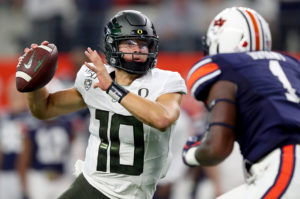
Oregon QB Justin Herbert – Photo by: Getty Images
So although a quarterback like Oregon’s Justin Herbert may be further down this board than most, it just means I think he’ll be a solid starter in the NFL (third-round grade definition), not that I wouldn’t take him until Round 3 as a team because quarterbacks have a higher positional value. A solid starter at quarterback is obviously worth way more than a great starting running back. My Big Board just doesn’t account for that because I’m not an NFL team and I don’t need to stack my board like one. So read between the lines there.
Now you are free to hate on me from a place of understanding – rather than ignorance. Enjoy!
“Can’t Miss” Grades
1. Joe Burrow, QB, LSU
Best quarterback prospect I’ve ever scouted.
2. Chase Young, EDGE, Ohio State
How can a dude so gigantic make himself so small around the top of the arc when cornering as a pass rusher? Impossible for tackles to land strikes on him. What a football player.
3. Jeffrey Okudah, CB, Ohio State
In any other draft he’d be a comfortable best overall player. Lock-down, scheme-diverse cover corner from day one.
First-Round Grades
4. Jedrick Wills, OT, Alabama
The most explosive and ferocious tackle in the class. Wills does everything you want at the tackle position, and he does it at a high level as long as his shoulders check out medically.
5. CeeDee Lamb, WR, Oklahoma
All-around stud receiver who can thrive in any system and play inside or outside.
6. Jerry Jeudy, WR, Alabama
The best route runner in the class. Wins with the ball in his hands and before the ball arrives.
7. Tua Tagovailoa, QB, Alabama
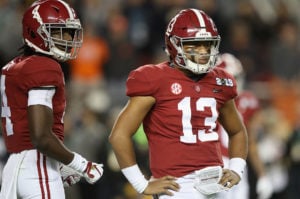
Alabama WR Jerry Jeudy and QB Tua Tagovailoa – Photo by: Getty Images
There are a lot of open throws in Alabama’s offense, and Tagovailoa will definitely be tested more in the NFL. But the mental makeup, accuracy, mobility and (mostly) decision-making that you want are already in place. He’s worth the slight risk (hip and ankle injuries) at this position.
8. Isaiah Simmons, Avenger, Clemson
I don’t think you can truly assign him to one position or role in the NFL, and because of that it is very difficult to value where he should be selected. I think playing weakside linebacker is a good start, but with NFL defenses predominantly operating out of nickel, Simmons’ ability to play as a big slot defender or also kick into deep coverage or blitz is a huge advantage for a defense with some creativity at coordinator.
9. Javon Kinlaw, DT, South Carolina
The best pass-rushing defensive tackle in the class and the most disruptive in the run game as well. Kinlaw can brush up the details at the next level, when you have traits, motor and toughness like his consistency and perfect technique are a bit overrated.
10. Henry Ruggs III, WR, Alabama
His speed alone is probably worthy of first round consideration, but combine that with Ruggs ball skills (which we saw more of in 2018) and run-after-catch ability, and you have a playmaker who should thrive in the NFL.
11. Mekhi Becton, OT, Louisville
There’s risk here because Becton has taken so few true pass sets in Louisville’s run-heavy, RPO offense, but what we’ve seen looks great on tape. His size, terrific functional athleticism (which means he knows how to move at his position rather than just being a great mover) and nasty demeanor are worth the risk in my opinion. At this position, you roll the dice on traits and tape like this.
12. Tristan Wirfs, OT, Iowa
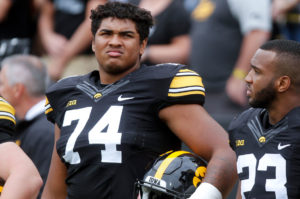
Iowa RT Tristan Wirfs – Photo by: Getty Images
Wirfs can do everything you want at the tackle position at a high level, just like Wills, but he doesn’t have the consistency of his Alabama counterpart. If he starts playing nasty on a consistent basis and cleans up his footwork, the sky is the limit for Wirfs. He’s insanely talented.
13. Ashtyn Davis, S, California
This one will surprise some people, but Davis is the best free safety in the class and he has excellent man coverage ability. The most important abilities a safety can possess are coverage abilities, which manifest themselves at their peak in range and ball skills. Davis has both. It doesn’t hurt that he’s an elite athlete with great size, character and football IQ. I don’t take injury history (he missed the Combine after having surgery for a groin injury on Nov. 30) into account in my evaluations, so dock him a bit for that as you will.
Second-Round Grades
14. Patrick Queen, LB, LSU
Queen’s tape was among the most impressive 2019 season performances that I’ve seen from any player. Take into account that it was his first year as a starter, and you have to be thrilled about the kind of upside you’re getting against the run and in coverage from this speedy linebacker.
15. Justin Jefferson, WR, LSU
I’m a big fan of Jefferson’s game, and when he knocked the Combine out of the park I went all in after some early draft process reservations. You gotta know where he wins and he might always be best in the slot, but Jefferson’s ball skills, route-running and smarts are what wins in the middle of the field these days, and he can even make plays vertically as well.
16. Andrew Thomas, OT, Georgia
I don’t think Thomas has the athletic talent of the top three tackles in the class, but he’s a technician who should start for a long time in the NFL. Given the importance of his position, I’m comfortable with him as a Top 10 pick.
17. K’Lavon Chaisson, EDGE, LSU
 You don’t have to tell me about how much of a risk it is to have Chaisson this high – I get it. Very few edge defenders in NFL history have had less than double-digit career sacks in college and gone on to success at the pro level. But if we’re betting on outliers, they better have elite pass rush athleticism (burst, speed, bend/flexibility, change-of-direction), high-end reps against top college competition and love football. Chaisson checks all those boxes. Let’s roll the dice.
You don’t have to tell me about how much of a risk it is to have Chaisson this high – I get it. Very few edge defenders in NFL history have had less than double-digit career sacks in college and gone on to success at the pro level. But if we’re betting on outliers, they better have elite pass rush athleticism (burst, speed, bend/flexibility, change-of-direction), high-end reps against top college competition and love football. Chaisson checks all those boxes. Let’s roll the dice.
18. Derrick Brown, DT, Auburn
Most have him higher, and I understand. Brown is a really good football player. But if I’m drafting a defensive tackle high, I want him to impact the quarterback consistently. That’s not Brown. He’ll be a monster against the run and push the pocket enough to stay on the field as a pass rusher at the next level, which makes him a very safe pick.
19. Cesar Ruiz, IOL, Michigan
The best interior offensive lineman in the draft and one of the youngest players in the class. Ruiz should keep getting better, and he’s already pretty good. He’s the type of center that could find his way into Round 1.
20. C.J. Henderson, CB, Florida
I’m definitely nervous to put Henderson this high, but the bottom line is that he consistently flashes and has maybe the best physical and athletic tools in the class. He has to make more plays at the catch point and be more aware in zone coverage. Everything is there for Henderson to become a star, now can he become more consistent?
21. Zack Baun, LB, Wisconsin
There’s projection needed with Baun, but guys with great football IQ and physicality who can move like he can are the ones you bet on. He brings legit speed/bend edge pass rush and coverage skills on long/late downs, the question is can he key-and-diagnose against the run on early downs from an off-ball alignment?
22. Bryan Edwards, WR, South Carolina
There are things about Edwards’ game that need brushing up at the next level, but he’s a very good athlete, who can win at all three levels of the field. Not many receivers got behind top SEC corners, won above-the-rim consistently and can be effective with the ball in their hands. He’s gonna get drafted much later than this (second or third round) and be a steal.
23. Michael Pittman, WR, USC
I love Pittman’s game, because he isn’t just a big possession receiver, he’s a three-level separator with outstanding ball skills. He wins vertically despite not being a burner, and he dominates corners underneath. He’s got big-time speed and physicality, too.
24. Antoine Winfield, S, Minnesota
Winfield’s injury history might push him down to the third round, but he’s a stud when he’s on the field. Ball skills and instincts are his calling card, and if he can clean up his footwork a little bit in deep coverage, he could make even more splash plays in the NFL.
25. Josh Jones, OT, Houston
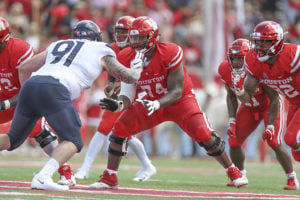
Houston OT Josh Jones – Photo courtesy of Univ. of Houston
I’m a big Josh Jones fan because I like offensive linemen that don’t lose one-on-one on tape – like, ever. Granted, the jump in competition will be significant for Jones, but if he refines his footwork, he can be a quality starter in the NFL.
26. A.J. Terrell, CB, Clemson
Terrell played much better in the National Championship Game than many give him credit for, and he was outstanding the rest of the season. Not many corners with his length and size can move with that much fluidity. His best football should be ahead of him.
27. Clyde Edwards-Helaire, RB, LSU
If you want height and long speed in a running back, go elsewhere, but you’ll be missing out on the stuff that matters. CEH has elite vision and patience, breaks tackles, makes defenders miss in space, catches the football extremely well, runs receiver routes from wide alignments, pass protects, doesn’t fumble and will come to work every day looking to get better.
28. K.J. Hamler, WR, Penn State
Yeah, there’s risk having a 5-foot-9 slot receiver this high up the board, but Hamler is one of the fastest football players in the world and he plays to that speed constantly. I’ll live with a few drops for his speed and elusiveness.
29. Brandon Aiyuk, WR, Arizona State
The more I watched Aiyuk, the more I became enamored with how he wins as a receiver. The lack of route-running polish and inconsistent hands are frustrating, but not many guys can maintain full speed through every change of direction in their route. He’s a splash-play role player out of the gate as a rookie.
30. Terrell Burgess, NCB/S, Utah
You’ve gotta decide how you value the nickel cornerback position on your defense, but if you’re looking for one, they don’t come much better than Burgess. He was lock-down all season long while also playing elite deep safety coverage in two-high shells at Utah.
31. D’Andre Swift, RB, Georgia
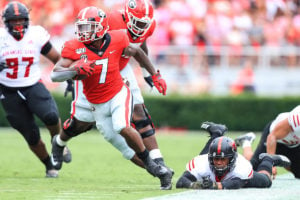
Georgia RB D’Andre Swift – Photo by: Getty Images
I don’t think Swift is a bell-cow feature runner, but can he help your offense in the passing game in a dynamic way out of the gate? Yep. Get him in a zone-running scheme and through the first level of the defense, and he’ll make defenders’ ankles pay in space.
32. Jeff Gladney, CB, TCU
I’m worried about how Gladney got pushed around in certain spots last season, but it certainly wasn’t for lack of effort. He competes at a high level and finds the football extremely well. He’s got freakishly long arms for a 5-foot-10 corner too, which will help.
33. Denzel Mims, WR, Baylor
Man, Mims’ tape is frustrating, but if he plays in the NFL how he competed at the Senior Bowl, the lights could go out fast on opposing corners. Can he maintain that intensity level and continue to separate like crazy? Because we know the ball skills, speed and body control are there if Mims can get the details right.
34. Justin Madubuike, DT, Texas A&M
I love Madubuike’s explosiveness and hot motor, and he showed at the Combine that he has the elite athletic ability to offset being a smaller defensive tackle. His get-off and his rush plan have to improve, but the ability seems to be there.
35. Cam Akers, RB, Florida State
Akers may not be elite in any one area, but he’s very balanced and will benefit from playing behind a much better offensive line at the next level. I love backs that can make people miss and run through a linebacker’s face, and Akers can do both. Can he keep growing as a receiver?
36. Kenneth Murray, LB, Oklahoma
Full disclosure is that I have yet to finish Murray’s evaluation, but what I’ve seen is an inconsistent player from the neck up with very little quality coverage experience. Yet has elite athletic ability, football character and will wallop guys if he gets the chance.
37. J.K. Dobbins, RB, Ohio State
It’s hard to go wrong with Dobbins, even if the upside isn’t significant. He has terrific vision and decision-making to go with receiving ability and surprisingly strong pass protection for a college back. I just wish he made more people miss.
38. Jonathan Taylor, RB, Wisconsin
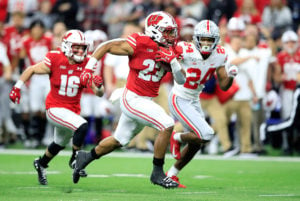
Wisconsin RB Jonathan Taylor – Photo by: Getty Images
Taylor is a great college running back who will be a strong starter in the NFL thanks to his vision and patience as a runner, but he doesn’t create enough extra offense for me to get really excited about him. I need a more dynamic impact in space or as a pass catcher to value a back higher than this.
39. K’Von Wallace, NCB/S, Clemson
Again, Wallace is a nickel corner so the value might not be ideal here, but he’s been a quality starter for Clemson for years, and his ball skills finally arrived in 2019. He is also one of the best tackling defensive backs in the class.
Third-Round Grades
40. Laviska Shenault, WR, Colorado
I really like aspects of Shenault’s game, but other than his run-after-the-catch ability, I’m not sure what he does right now at a high level. His potential is through the roof if he can stay healthy, but right now his strength and speed are best utilized in a package role – although that role can be quite explosive in the right offense.
41. Jalen Reagor, WR, TCU
I love Reagor’s speed and explosiveness, but the inconsistencies on his tape wore me down. Too many drops, too many average routes, too many struggles in contested situations, not the “elite” YAC ability I expected to see. Having said that, Reagor has flashed the ability to do everything as an outside receiver, including win above the rim. If he can find consistency at the next level, he has explosive playmaking upside down the field.
42. Xavier McKinney, S, Alabama
Everyone is going to wonder why I have McKinney this low, but I honestly really like his game. He’s smart, doesn’t blow assignments, does a bunch of things well, can match up with tight ends, can play in two-high looks, defends the run in the box. I just don’t know what he does at an elite level? Ball skills, single-high range, man coverage ability versus slot receivers … none of that is really McKinney’s game. He’s a good, steady, starting safety who can help a defense in a few ways, but I don’t see him as a high value player at his position.
43. Jaylon Johnson, CB, Utah
Johnson is going to be a starting corner in a press-Cover 3 defense or maybe even a press-man defense, and he’s probably going to make some plays, too. He’s got ball skills and instincts like that. The problem is he’s not very fluid or especially fast, and those two flaws lead to him getting incredibly grabby against route runners who can separate.
44. Robert Hunt, IOL, Louisiana-Lafayette
Mauling guards with tackle experience are my cup of tea, and while Hunt may need to iron out some kinks, I love what I’ve seen of his game so far. I should finish his evaluation by this time next week.
45. Grant Delpit, S, LSU

LSU S Grant Delpit – Photo by: Getty Images
Delpit is a starting free safety from day one in the NFL, but his poor tackling, ugly reps in man coverage and questionable overall athleticism limit his value and versatility. That could all end up okay however, if he’s able to get back to making big plays on the ball from a single-high alignment.
46. Jeremy Chinn, S, Southern Illinois
I’m a big fan of Jeremy Chinn, I’m just not sure how high to have a guy that I’ve just been able to see three games and a few semi-rough Senior Bowl practices of. He’s an awesome athlete with plenty of physicality and range for the position, and the flashes of ball skills are intriguing. I’m not sure he’s totally “ready” to start at any role in the NFL right away, and yet his athleticism, size and flashes make you want to start him at multiple spots as soon as possible.
47. Justin Herbert, QB, Oregon
I’m just not sure the traits match the mentality with Herbert, and that scares me. Was it the offense holding him back, or is that really just all he offers as a quarterback? The tools everyone talks about in his athleticism and big arm are clearly there, but we’ve got years of evaluations to show us how overrated that stuff is to decision-making, mental processing and accuracy – all areas that Herbert has been up-and-down at best.
48. Damon Arnette, CB, Ohio State
I really liked Arnette’s tape, as he showed the ability to play in a bunch of different alignments and still mirror-and-match receivers and make plays on the ball. But short arms, a 4.57 time in the 40-yard dash, and having some reported character concerns as an older prospect are red flags I’m not sure how to account for right now.
49. Joshua Uche, EDGE/LB, Michigan
I’ll admit I’m frustrated that Uche could barely see the field at Michigan, even in 2019, but it’s hard to deny his ability to make an impact when he was out there. He might not be the bendiest edge rusher, but he does have good hands and he’s explosive when he times his first step up. Uche practiced all year at Michigan as an off-ball linebacker, only to rarely play there on Saturdays. The coverage flashes we’ve seen are exciting.
50. Malik Harrison, LB, Ohio State
Harrison may not be here on my final Big Board, but I wanted him on this one because I think he’s one of the more slept-on prospects in the class. I’m not saying he’s gonna be a star, but Harrison is an outstanding run-defending linebacker with better than advertised athletic ability. He destroyed the Combine and no one is talking about it. Players with his instincts and physicality tend to stick at linebacker in the NFL.
Jon Ledyard is PewterReport.com's newest Bucs beat writer and has experience covering the Pittsburgh Steelers as a beat writer and analyzing the NFL Draft for several draft websites, including The Draft Network. Follow Ledyard on Twitter at @LedyardNFLDraft

